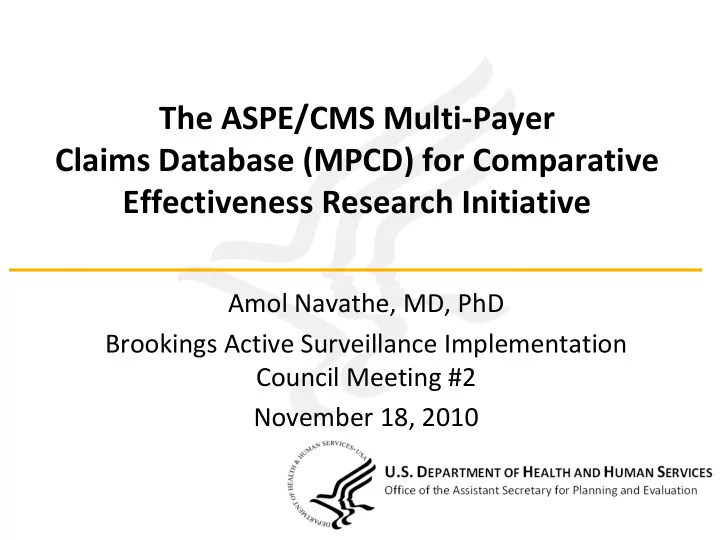

The ASPE/CMS Multi ‐ Payer Claims Database (MPCD) for Comparative Effectiveness Research Initiative Amol Navathe, MD, PhD Brookings Active Surveillance Implementation Council Meeting #2 November 18, 2010
ASPE/CMS CER Multi ‐ payer Claims Database • Objective: to build and operate a MPCD to support CER using public and private payer claims data – Continue to uphold privacy and protection of patients while • Building a comprehensive and diverse database to enable research on multiple priority populations, interventions, and conditions • Meaningfully engaging private sector in CER infrastructure development and research • Increasing access and usability of such data • Utilizing analytic tools to incorporate greater functionality • Laying the foundation for future enhancements with clinical data – CER broadly defined to include clinical and non ‐ clinical research 2
ASPE/CMS CER Multi ‐ payer Claims Database • Value: incorporating public and private data into one source will create value over existing disparate sources – Greater geographic coverage – Increased demographic and clinical representativeness – Ability to study less common conditions – Focus on effectiveness research (e.g. real life settings)
ASPE/CMS CER Multi ‐ payer Claims Database Flow of projects: • Phase I – Strategic and Technical Design • Strategic Design completed April 29, 2010 by Avalere Health • Technical Design and Pilot Test in progress – 2 awards • Vexcel/Microsoft • Thomson Reuters • Phase II – Implementation of MPCD 4
Strategic Design • Purpose – Evaluate design options that optimize sustainability and impact of data • Findings – MPCD will have advantages and additional potential uses versus existing claims data sources – Two key challenges, data partnership and patient privacy protections, motivate technical and strategic needs – Potential approaches include state ‐ based, plan ‐ based, employer ‐ based, and “hybrid” – Recommend federated “hybrid” approach with private aggregator leveraging existing multi ‐ payer claims data resources and incorporating state ‐ based and other data when possible – Many open questions to be addressed in design phase of Implementation project 5
Technical Design and Pilot Test • Purpose – Evaluate technical feasibility and application performance with eye toward • Rapid data integration to support distributed database design • Value of next generation analytic applications and tools for health data • Advantage of resource combining public and private payer data • Deliverables – Test database linking data, including private payor data, across sources and settings in a rapid prototyping environment – Sample research analyses to demonstrate utility of • Combined public/private payer data • Analytic tools/user Interface 6
Takeaways for MPCD to date • Investment in a flexible platform will greatly enhance utility in the short ‐ term and capability to scale long ‐ term – Administrative data will be able to • Analyze trends • Conduct health services research • Allow major comparisons (e.g. surgery vs medical mgmt for mortality outcome) • Generate hypotheses – Challenges still include • Privacy, privacy, privacy (especially when linking data) • Data ownership • Many questions requiring clinical data
Takeaways for MPCD to date • Need to actively engage potential data partners on open questions from inception – Technical design and data contribution, e.g. • Protecting privacy • Release of data – Coordinate/synergize with existing projects such as Mini ‐ Sentinel • Common Data Model development • Outreach to potential data contributors • Lessons and best practices in infrastructure building
Takeaways for MPCD to date • Analytic tools likely need further development to be useful “off ‐ the ‐ shelf” for research • Distributed data network approach has a range of meanings and approaches from a technological perspective
CER Multi ‐ payer Claims Database Implementation • Initial Design Plans – “Hybrid” approach with a central repository of less sensitive data + distributed queriable network for “non ‐ core” data • Central repository to include CMS data, data from contractor, and any other contributions from partners • Distributed network partners will establish guidelines for contribution including ability to screen requests on a query ‐ by ‐ query basis – Will engage several potential partners in addition to data agreements in place with contractor – Plan to engage states through NAHDO and RAPHIC 10
CER Multi ‐ payer Claims Database Implementation Timeline – Within 78 weeks: Testing and – First 25 weeks: Design phase enhancements • Re ‐ visit key technical and • Database validation strategic design options • Develop user documentation • Convene Governance board • Open MPCD for greater use • Identify and establish data partnerships • Perform proof ‐ of ‐ concept analyses • Establish common data model – Within 108 weeks: Plan for – Within 52 weeks: Initial maintenance, sustainability, and infrastructure setup further scalability • Execute technical design and implementation plans • Create test version of MPCD with at least central repository and framework for distributed network 11
Amol Navathe, MD, PhD Medical Officer and Senior Program Manager, Comparative Effectiveness Portfolio amol.navathe@hhs.gov 202 ‐ 690 ‐ 6461 www.aspe.hhs.gov
Recommend
More recommend